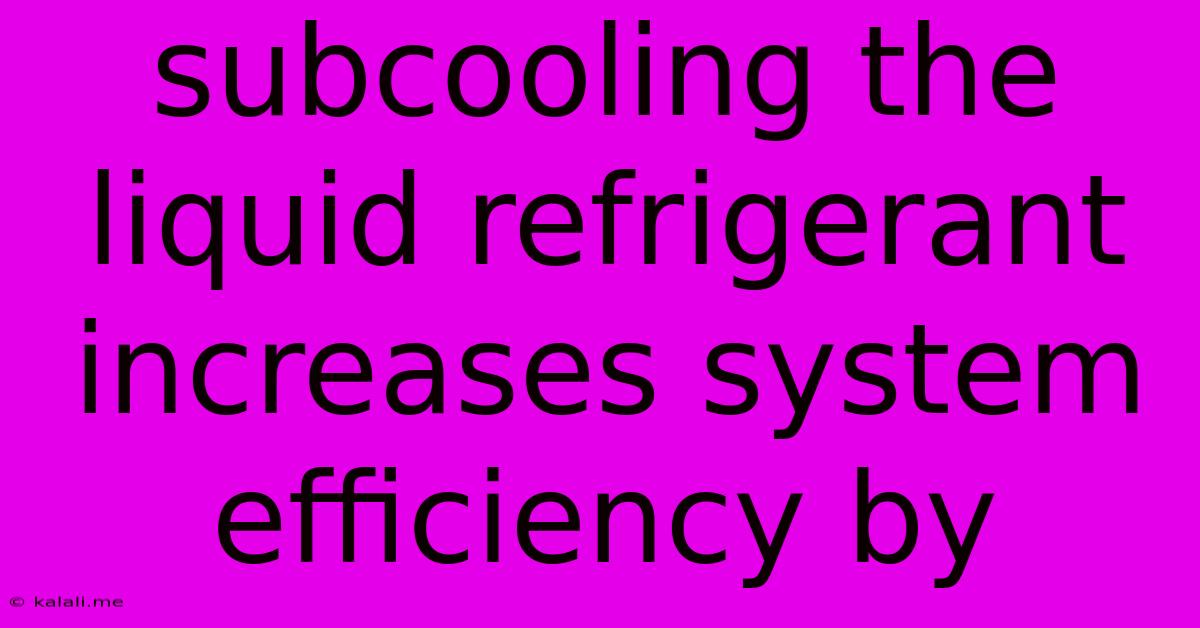Subcooling The Liquid Refrigerant Increases System Efficiency By
Kalali
Jun 15, 2025 · 3 min read

Table of Contents
Subcooling the Liquid Refrigerant: A Key to Increased System Efficiency
Subcooling the liquid refrigerant is a crucial aspect of optimizing refrigeration and air conditioning system efficiency. This process, often overlooked, can significantly improve performance and reduce energy consumption. This article delves into the mechanics of subcooling, explaining how it enhances system efficiency and highlighting practical implications for improved system design and maintenance.
What is Subcooling?
Subcooling refers to the process of cooling the liquid refrigerant below its saturation temperature at a given pressure. Imagine a refrigerant at its saturation point: any further reduction in temperature will cause it to start condensing into a liquid. Subcooling occurs after this condensation process is complete, resulting in a colder, denser liquid refrigerant.
How Subcooling Increases Efficiency
The benefits of subcooling stem from its impact on several key aspects of the refrigeration cycle:
-
Reduced Flash Gas: One major advantage is the reduction of flash gas. Flash gas is the vapor that forms when the liquid refrigerant absorbs heat as it flows through the expansion valve. A subcooled liquid, being colder, is less prone to this vaporization. Less flash gas means less refrigerant vapor that needs to be recompressed, saving energy and improving the overall efficiency of the system.
-
Improved Volumetric Efficiency: The density of the subcooled liquid is higher. This means that more refrigerant mass can be delivered to the evaporator for a given volume. Consequently, the system's volumetric efficiency improves, meaning more cooling capacity for the same amount of refrigerant circulated.
-
Increased Evaporator Capacity: As less energy is wasted on recompressing flash gas, the evaporator can operate more effectively. This leads to better heat transfer and increased cooling capacity.
-
Reduced Compressor Work: Because of the reduced flash gas and the improved refrigerant flow, the compressor has less work to do, ultimately reducing energy consumption and extending the compressor's lifespan.
-
Better System Control and Stability: Subcooling contributes to a more stable and controllable refrigeration system. With less flash gas, pressure fluctuations are minimized, ensuring consistent performance and preventing potential issues.
Practical Implications and Best Practices
-
Proper Sizing of Components: Ensure the condenser and liquid line are correctly sized to accommodate subcooling. An undersized condenser can limit the level of subcooling achieved.
-
Monitoring Subcooling: Regularly monitoring the subcooling temperature is crucial for optimizing system performance. This can be done using temperature sensors in the liquid line.
-
System Maintenance: Regular maintenance, including cleaning the condenser coils and ensuring proper refrigerant charge, helps maximize the effectiveness of subcooling.
-
Effective Insulation: Proper insulation of the liquid line minimizes heat gain and helps maintain the subcooled state of the refrigerant.
Conclusion:
Subcooling is a simple yet highly effective technique for boosting refrigeration and air conditioning system efficiency. By reducing flash gas, improving volumetric efficiency and enhancing evaporator performance, subcooling leads to lower energy consumption, improved system stability and prolonged equipment lifespan. Understanding and implementing proper subcooling practices is vital for achieving optimal system performance and minimizing operational costs. By incorporating this crucial element into system design and maintenance, significant gains in efficiency and sustainability can be realized.
Latest Posts
Latest Posts
-
What Are The Prime Factors Of 192
Jun 16, 2025
-
How Many Molecules Are In 2 Moles Of H2o
Jun 16, 2025
-
What Does The Area Under The Velocity Time Graph Represent
Jun 16, 2025
-
Which Mountain Range Separates France From Spain
Jun 16, 2025
-
Compare And Contrast Phytoplankton And Zooplankton
Jun 16, 2025
Related Post
Thank you for visiting our website which covers about Subcooling The Liquid Refrigerant Increases System Efficiency By . We hope the information provided has been useful to you. Feel free to contact us if you have any questions or need further assistance. See you next time and don't miss to bookmark.